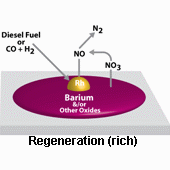BASF will introduce its LNT+CS4F™ emissions control system for diesel engines at the International Vienna Motor Symposium, being held May 8 to 9, 2014, in Vienna, Austria. The new system combines the features of a Lean NOx Trap (LNT) and a multifunctional catalyzed soot filter (CS4F).
The LNT+CS4F can remove PM (Particulate Matter), as well as CO (Carbon Monoxide), HC (Hydrocarbons) and NOx (Nitrogen Oxides) from diesel-engine exhaust, helping automakers meet strict new emissions regulations including Euro 6c.
To meet NOx emission limits under these demanding conditions, LNT catalysts for Euro 6c must have fast NOx adsorption kinetics and high NOx adsorption capacity when compared with LNT technologies developed for Euro 6a applications. A multifunctional catalyzed soot filter (CS4F) is also required to remove PM plus convert secondary emissions like ammonia (NH3), hydrogen sulfide (H2S), CO, and HC resulting from soot filter and LNT regeneration, and to remove additional NOx, increasing the NOx reduction activity of the overall system.
The LNT+CS4F system will be showcased in a presentation led by Dr. Klaus Harth, BASF’s Vice President, Environmental Catalysis Research, which takes place at 2:45 pm on May 9 at the Congress Center Hofburg Vienna.
“The combination of newly developed NOx storage materials with tailored precious metal particles led to this improved LNT technology for Euro 6c legislation,” said Dr. Harth. “In addition, the development of the new CS4F multifunctional catalyzed soot filter was required to further enhance the emissions reduction performance for diesel passenger car applications.”
Compared to the LNT+CSF+UF-SCR (Under Floor – Selective Catalytic Reduction) catalyst system already in the market, the LNT+CS4F system eliminates one catalytic component, resulting in lower system weight, space and complexity. However, a filter with high porosity is required to incorporate all these functions, and the component must be carefully designed so that it also meets the particle number regulation. In addition, the exhaust backpressure should not increase when changing from the LNT+CSF+UF-SCR system to the two-component LNT+CS4F system.
“The final application of such advanced LNT+CS4F catalyst systems can only be realized by working together within the supply chain: substrate and filter suppliers and OEM customers,” said Xavier Susterac, BASF’s Vice President, Mobile Emissions Catalysts Europe. “BASF will continue its development efforts to further increase the robustness and durability of catalyst technologies and to support the realization of cost-effective emission control solutions.”
Euro 6 legislation will be implemented in 2014. This legislation requires a significant decrease of NOx emissions to less than 80 mg/km when evaluated under the New European Driving Cycle (NEDC). With the implementation of Euro 6c in 2017, still tighter requirements will come into play. Real Driving Emission (RDE) requirements will be applied, and will be evaluated using PEMS (Portable Emission Measurement Systems). These new conditions will lead to new challenges for the after-treatment systems.
Source: BASF
Romain’s opinion:
This kind of emission system is convenient from a packaging perspective compared to a system with both LNT and SCR. But I don’t know many vehicles yet equipped with both LNT and SCR. Do you think that such a complex after-treatment system will be needed to reach Euro6 step c? Or is it developed to anticipate Euro7 regulation?




















